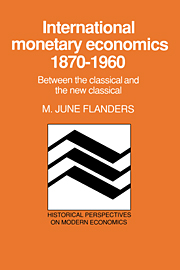Book contents
- Frontmatter
- Contents
- Preface
- 1 Preliminaries
- 2 Stream P
- 3 The beginnings of the neoclassical tradition
- 4 The locus classicus of the neoclassical position
- 5 The Macmillan Committee
- 6 A second diversion: Keynes and the Macmillan Committee
- 7 The anti-neoclassicals
- 8 Indian currency and finance: a tract on monetary reform
- 9 A treatise on money
- 10 Late Keynes: towards Bretton Woods
- 11 The crisis writers
- 3 Stream F
- 4 The confluence
- Ex post
- Bibliography
- Index
5 - The Macmillan Committee
Published online by Cambridge University Press: 12 October 2009
- Frontmatter
- Contents
- Preface
- 1 Preliminaries
- 2 Stream P
- 3 The beginnings of the neoclassical tradition
- 4 The locus classicus of the neoclassical position
- 5 The Macmillan Committee
- 6 A second diversion: Keynes and the Macmillan Committee
- 7 The anti-neoclassicals
- 8 Indian currency and finance: a tract on monetary reform
- 9 A treatise on money
- 10 Late Keynes: towards Bretton Woods
- 11 The crisis writers
- 3 Stream F
- 4 The confluence
- Ex post
- Bibliography
- Index
Summary
The committee
The Committee on Finance and Industry was appointed on November 5, 1929, by the Chancellor of the Exchequer “to inquire into banking, finance and credit, paying regard to the factors both internal and international which govern their operation, and to make recommendations calculated to enable these agencies to promote the development of trade and commerce and the employment of labour” (Macmillan 1931: vi). It thus had a much broader frame of reference than the Cunliffe Committee, and, of course, sat at a very different time in British, and world, history. It convened for a much longer period than the Cunliffe Committee, and we have two large volumes of hearings and testimony, as well as a long and detailed report, which was presented in June 1931. Bradbury, now a Lord, was back. The economists in the group were T. E. Gregory and J. M. Keynes.
The reports are separated by a period of thirteen years, the return to gold, and the beginnings of the greatest depression the world had, and has, ever known. They are distinguished from one another by a number of other characteristics as well: their length, the breadth of their terms of reference and hence the scope of their concerns, their view of the world, of economic adjustments in general and of balance of payments adjustment in particular, their perception of the actual and appropriate behavior of a central bank (or at least of a particular central bank, the Bank of England), and (only partly facetiously do I say this) by John Maynard Keynes.
- Type
- Chapter
- Information
- International Monetary Economics, 1870–1960Between the Classical and the New Classical, pp. 87 - 106Publisher: Cambridge University PressPrint publication year: 1990



